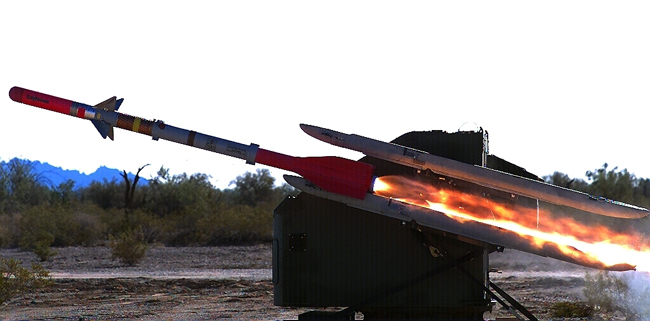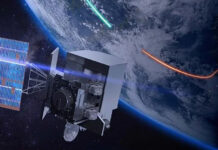
On a recent firing test Raytheon has successfully intercepted and destroyed a 107mm rocket target in flight. According to Raytheon, the targets were fired at low quadrant elevation (QE) and were intercepted by the Accelerated Improved Intercept Initiative (AI3) interceptor, as part of the second series of guided test vehicle (GTV) flight tests of the AI3 program. The US Army is expected to embark on live-fire engagements beginning in September 2013. On these tests the AI3 will engage 107mm and other rockets, unmanned air systems (UAS) and other threats to forward operating bases.
The interceptor is a variant of the AIM-9 missile, designed to intercept short range ballistic rockets, mortars, unmanned aerial vehicles and other air breathing platforms. The AI3 Battle element employs a modified Avenger weapon system as a launching platform, comprising common launcher rails supporting AI3, AMRAAM (AIM-120) and Sidewinder (AIM-9) missiles. The primary sensor for the system is the Ku Radio Frequency System (KRFS) fire control radar. The radar and launcher are fully integrated with the Army’s new Integrated Air and Missile Defense Integrated Battle Command System.
“This second GTV demonstrated full integration of the AI3 Battle Element with the C-RAM command and control architecture against the threat target,” said Steve Bennett, Raytheon Missile Systems AI3 Program Director. Immediately after the 107mm target rocket was fired it was picked by the KRFS radar. After the AI3 interceptor was launched, the KRFS continued to track the inbound target, guiding the interceptor via inflight radio frequency (RF) data link updates to position itself at the terminal intercept course. At that position the interceptor transitioned to terminal guidance, using its onboard seeker, assisted by the illumination from the KRFS radar, guiding the interceptor missile to within lethal range. The target was then detected using an active RF proximity fuze that determined the optimal detonation time for the warhead. With these measurements, the missile calculated the appropriate warhead burst time and defeated the incoming threat.
“Beginning only 18 months and one week ago, and with firm cost requirements, the AI3 interceptor project successfully engaged and destroyed an inflight rocket on a challenging, high-speed flight profile greatly enhancing the range of existing capabilities,” said Michael Van Rassen, the U.S. Army’s Project Director for Counter Rockets, Artillery and Mortars (C-RAM) and AI3. “The project used a system of systems approach that lowered risk and enabled an accelerated schedule by leveraging existing government components and off the shelf subsystems to expand the footprint of the protected area for our warfighters.” Van Rassen added.
Other technologies to be tested under the government sponsored evaluation are an EAPS hit-to-kill interceptor developed by Lockheed Martin, and another missile, using fragmentation warhead triggered by proximity fuse, developed by Northrop Grumman. Unlike the two missiles that were specially designed for the EAPS application, AI3 employs an existing weapon (Sidewinder, Avenger), which would be modified for the C-RAM missions. The KRFS also employs existing assets – the Ku Band Multi-function RF System (MFRFS), an electronically-scanned, solid-state phased array radar originally developed to support Active Protection Systems (APS) on future combat vehicles. The static threat warning variant was developed and deployed to provide early warning from rocket threats fired at Low Quadrant Elevation. Utilizing residual assets from the Future Combat Systems (FCS) program, MRFRS was completed in 14 months, delivering 12 systems to protect forward bases in theater.




















